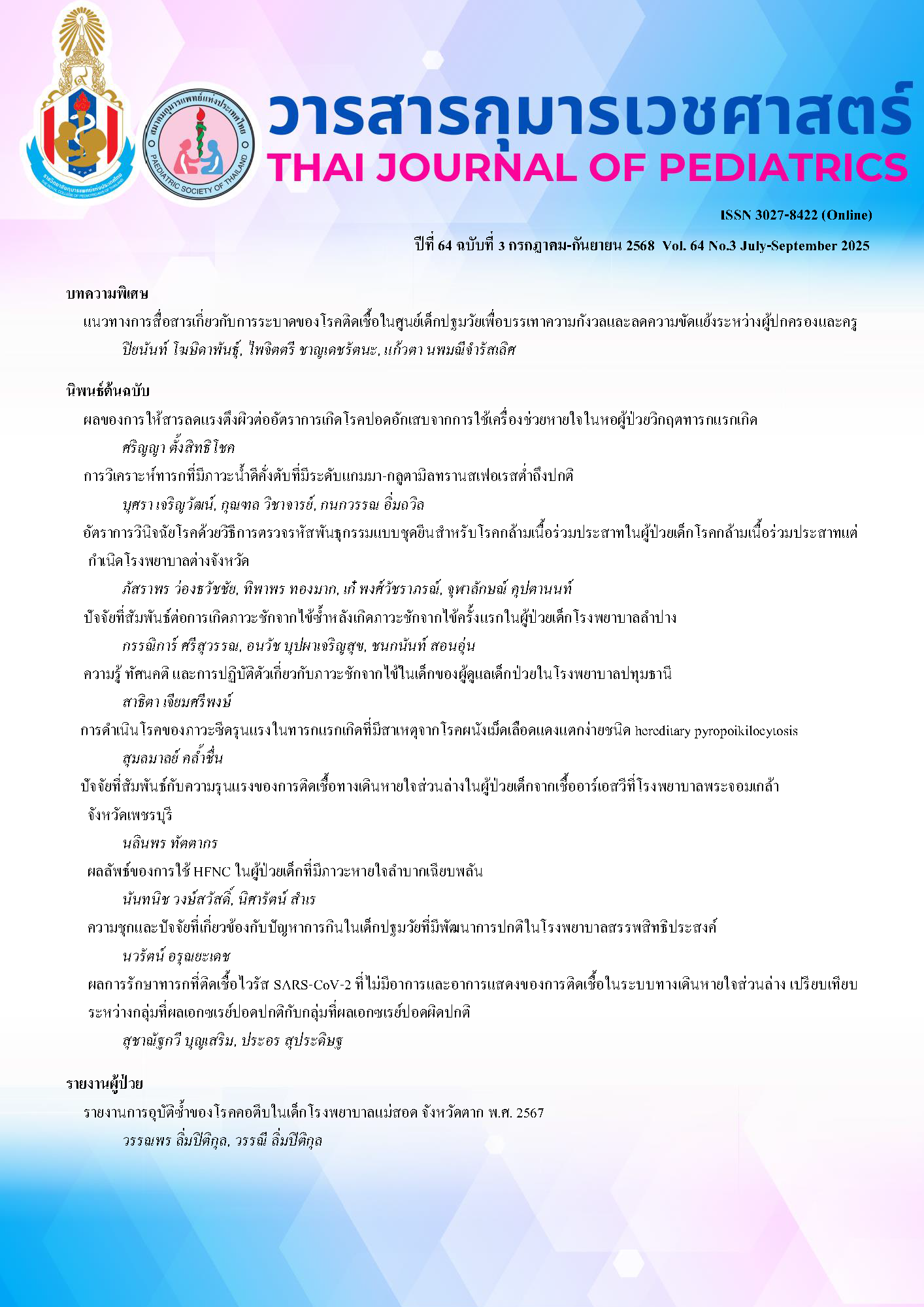ผลของการให้สารลดแรงตึงผิวต่ออัตราการเกิดโรคปอดอักเสบจากการใช้เครื่องช่วยหายใจในหอผู้ป่วยวิกฤตทารกแรกเกิด
คำสำคัญ:
สารลดแรงตึงผิว, ใส่ท่อช่วยหายใจ, ภาวะหายใจลำบากตั้งแต่แรกเกิด, โรคปอดอักเสบจากการใช้เครื่องช่วยหายใจบทคัดย่อ
ความเป็นมา: ปอดอักเสบที่เกี่ยวข้องกับการใช้เครื่องช่วยหายใจ (ventilator-associated pneumonia หรือ VAP) เป็นภาวะแทรกซ้อนที่สำคัญในทารกแรกเกิดที่ได้รับการช่วยหายใจด้วยเครื่องช่วยหายใจแบบใส่ท่อช่วยหายใจ ส่งผลให้มีอัตราการเจ็บป่วยและเสียชีวิตสูงขึ้น การให้สารลดแรงตึงผิวปอด (surfactant therapy) เป็นการรักษาที่ใช้กันอย่างแพร่หลายในภาวะหายใจลำบากตั้งแต่แรกเกิด (respiratory distress syndrome; RDS) ในทารกแรกเกิด แต่ผลกระทบของการใช้สารลดแรงตึงผิวต่ออุบัติการณ์ของ VAP ยังไม่ชัดเจน
วัตถุประสงค์: เพื่อประเมินว่าการให้สารลดแรงตึงผิวมีผลต่อการลดอุบัติการณ์ของ VAP ในทารกแรกเกิดที่ได้รับการช่วยหายใจด้วยเครื่องช่วยหายใจแบบใส่ท่อช่วยหายใจหรือไม่
วิธีการศึกษา: เป็นการศึกษาย้อนหลัง ( retrospective study) โดยการทบทวนเวชระเบียนที่โรงพยาบาลพิจิตร ในทารกแรกเกิดที่เข้ารับการรักษาในหอผู้ป่วยวิกฤตทารกแรกเกิด (NICU) และใช้เครื่องช่วยหายใจแบบใส่ท่อช่วยหายใจ ระหว่างวันที่ 1 กันยายน พ.ศ.2555 ถึง 30 กันยายน พ.ศ.2564 แบ่งเป็น 2 กลุ่ม คือ กลุ่มที่ได้รับสารลดแรงตึงผิว และกลุ่มที่ไม่ได้รับสารลดแรงตึงผิว ข้อมูลประชากร ลักษณะทางคลินิก และผลลัพธ์ถูกรวบรวมและวิเคราะห์
ผลการศึกษา: มีทารกแรกเกิดเข้าร่วมทั้งหมด 132 ราย โดยแบ่งกลุ่มละ 66 ราย กลุ่มที่ได้รับสารลดแรงตึงผิวมีอุบัติการณ์ของ VAP ต่ำกว่ากลุ่มที่ไม่ได้รับอย่างมีนัยสำคัญ (ร้อยละ 27.3 เทียบกับ ร้อยละ 54.6, p value 0.002) นอกจากนี้ กลุ่มสารลดแรงตึงผิวยังมีระยะเวลาการช่วยหายใจด้วยเครื่องช่วยหายใจสั้นกว่าอย่างมีนัยสำคัญ (6 วัน เทียบกับ 8 วัน, p value 0.023) แต่ไม่พบความแตกต่างอย่างมีนัยสำคัญของระยะเวลาพักรักษาใน NICU หรืออัตราการตายระหว่างสองกลุ่ม
สรุป: การให้สารลดแรงตึงผิวสัมพันธ์กับการลดอุบัติการณ์ของ VAP ในทารกแรกเกิดที่ได้รับการช่วยหายใจด้วยเครื่องช่วยหายใจแบบใส่ท่อช่วยหายใจ ผลการศึกษานี้ชี้ให้เห็นว่า การใช้สารลดแรงตึงผิวอาจมีประโยชน์นอกเหนือจากการรักษา RDS โดยช่วยลดความเสี่ยงของการเกิด VAP ในประชากรทารกที่เปราะบางกลุ่มนี้
Downloads
เอกสารอ้างอิง
Cernada M, Aguar M, Brugada M, Gutiérrez A, López JL, Castell M, et al. Ventilator-associated pneumonia in newborn infants diagnosed with an invasive bronchoalveolar lavage culture technique: A prospective observational study. Pediatr Crit Care Med. 2013;14:55–61.
Foglia EE, Meier MD, Elward A. Ventilator-associated pneumonia in neonatal and pediatric intensive care unit patients. Clin Microbiol Rev. 2007;20:409–25.
Tripathi S, Malik GK. Neonatal ventilator-associated pneumonia: An emerging threat. Pediatr Pulmonol. 2010;45:889–93.
Rangelova V, Kevorkyan A, Raycheva R, Krasteva M. Ventilator-associated pneumonia in the neonatal intensive care unit—incidence and strategies for prevention. Diagnostics (Basel). 2024;14:240.
Gupta A, Dutta S, Narang A. Ventilator-associated pneumonia in neonatal intensive care unit: A prospective study from a developing country. J Trop Pediatr. 2011;57:453–8.
Nuntiyagul T. Ventilator-associated pneumonia in premature infants in a neonatal intensive care unit at Chaoprayayommaraj Hospital: The rates, risk factors, and outcomes. J Health Sci Suppl III. 2008;17:203–12.
Dani C, Corsini I, Poggi C. Surfactant therapy for respiratory distress syndrome in preterm infants: When and what. Drugs. 2021;81:447–57.
Wongkhonkaen C, Paopongsawan P, Jirapradittha J, Kiatchoosakun P. Outcomes comparison of early versus late surfactant replacement therapy in neonates with respiratory distress syndrome. Siriraj Med J. 2023;75:330–42.
Ramanathan R. Optimal surfactant strategy for respiratory distress syndrome: Do we have the final answer? Neonatology. 2017;111:408–14.
Sweet DG, Carnielli V, Greisen G, Hallman M, Ozek E, Pas AT, et al. European consensus guidelines on the management of respiratory distress syndrome – 2019 update. Neonatology. 2019;115:432–50.
Polin RA, Carlo WA. Surfactant replacement therapy for preterm and term neonates with respiratory distress. Pediatrics. 2014;133:156–63.
Liu J, Liu G, Wu H, Li Z. Efficacy study of pulmonary surfactant combined with assisted ventilation for acute respiratory distress syndrome management of term neonates. Exp Ther Med. 2017;14:2608–12.
Azab SFA, Sherbiny HS, Saleh SH, Elsaeed WF, Elshafiey MM, Siam AG, et al. Reducing ventilator-associated pneumonia in neonatal intensive care unit using "VAP prevention Bundle": A cohort study. BMC Infect Dis. 2015;15:314.
Rangelova VR, Raycheva RD, Kevorkyan AK, Krasteva MB, Kalchev YI. Ventilator-associated pneumonia in neonates admitted to a tertiary care NICU in Bulgaria. Front Pediatr. 2022;10:909217.
Kribs A, Roll C, Göpel W, Wieg C , Groneck P , Laux R, et al. Nonintubated surfactant application vs conventional therapy in extremely preterm infants: a randomized clinical trial. JAMA Pediatr. 2015;169:723–30.
Balany J, Bhandari V. Understanding the impact of infection, inflammation, and their persistence in the pathogenesis of bronchopulmonary dysplasia. Front Med (Lausanne). 2015;2:90.
Garland JS. Strategies to prevent ventilator-associated pneumonia in neonates. Clin Perinatol. 2010;37:629–43.
Elward AM, Warren DK, Fraser VJ. Ventilator-associated pneumonia in pediatric intensive care unit patients: Risk factors and outcomes. Pediatrics. 2002;109:758–64.
Iosifidis E, Evdoridou J, Agakidou E. Risk factors for enteral feeding intolerance in preterm neonates with respiratory distress syndrome and the effect of early surfactant therapy. BMC Pediatr. 2015;15:217.
ดาวน์โหลด
เผยแพร่แล้ว
รูปแบบการอ้างอิง
ฉบับ
ประเภทบทความ
สัญญาอนุญาต
ลิขสิทธิ์ (c) 2025 ราชวิทยาลัยกุมารแพทย์แห่งประเทศไทย และ สมาคมกุมารแพทย์แห่งประเทศไทย

อนุญาตภายใต้เงื่อนไข Creative Commons Attribution-NonCommercial-NoDerivatives 4.0 International License.



